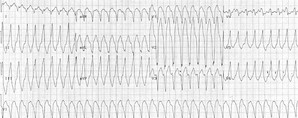Arrhythmogenic right ventricular dysplasia
Arrhythmogenic right ventricular dysplasia (ARVD, also known as arrhythmogenic right ventricular cardiomyopathy or ARVC) is a type of nonischemic cardiomyopathy that involves primarily the right ventricle. It is characterized by hypokinetic areas involving the free wall of the right ventricle, with fibrofatty replacement of the right ventricular myocardium, with associated arrhythmias originating in the right ventricle. more...
Overview
ARVD is an important cause of ventricular arrhythmias in children and young adults. It is seen predominantly in males, and 30-50% of cases have a familial distribution. It is usually inherited in an autosomal dominant pattern, with variable expression. The penetrance is 20-35% in general, but significantly higher in Italy. Seven gene loci have been implicated in ARVD. However, about 50% of families that express ARVD that undergo genetic screening do not show linkage with any of the known chromosomal loci. It is unclear whether the pathogenesis varies with the different loci involved. A standard genetic screening test is not available.
Naxos Disease
Naxos disease is an autosomal recessive variant of ARVD, described initially on the Greek island of Naxos. There, the penetrance is >90%. It involves the gene that codes for plakoglobin (a protein that is involved in cellular adhesion), on chromosome 17p. Naxos disease is described as a triad of ARVD, palmoplantar keratosis, and wooly hair. The signs of Naxos disease are more severe than with autosomal dominant ARVD.
Incidence
The incidence of ARVD is about 1/10,000 in the general population in the United States. It accounts for up to 17% of all sudden cardiac deaths in the young. In Italy, the incidence is 40/10,000, making it the most common cause of sudden cardiac death in the young in Italy.
Presentation
Up to 80% of individuals with ARVD present with syncope or sudden cardiac death. The remainder frequently present with palpitations or other symptoms due to right ventricular outflow tract (RVOT) tachycardia (a type of monomorphic ventricular tachycardia).
Symptoms are usually exercise-related. In populations where hypertrophic cardiomyopathy is screened out prior to involvement in competitive athletics, it is a common cause of sudden cardiac death.
The first clinical signs of ARVD are usually during adolescence. However, signs of ARVD have been demonstrated in infants.
Pathogenesis
The pathogenesis of ARVD is largely unknown. Apoptosis (programmed cell death) appears to play a large role. It is unclear why only the right ventricle is involved. The disease process starts in the subepicardial region and works its way towards the endocardial surface, leading to transmural involvement (possibly accounting for the aneurysmal dilatation of the RV). Residual myocardium is confined to the subendocardial region and the trabeculae of the RV. These trabeculae may become hypertrophied.
Aneurysmal dilatation is seen in 50% of cases at autopsy. It usually occurs in the diaphragmatic, apical, and infundibular regions (known as the triangle of dysplasia). The left ventricle is involved in 50-67% of individuals. If the left ventricle is involved, it is usually late in the course of disease, and confers a poor prognosis.
Read more at Wikipedia.org


